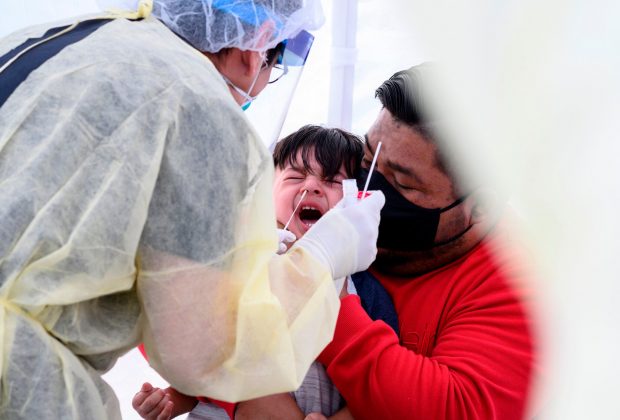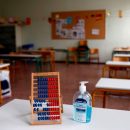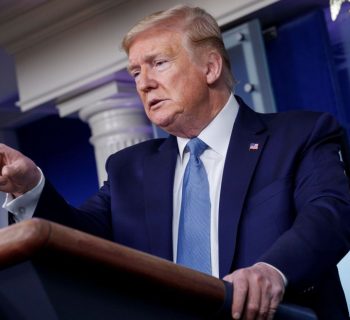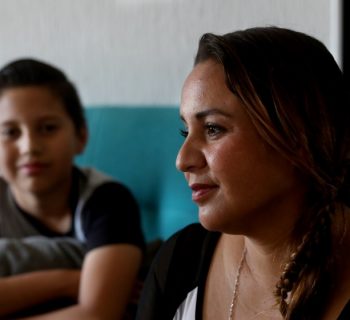By: The New York Times ~ August 9, 2020
Trump’s unilateral economic relief actions come under fire. Ohio’s governor urges use of rapid tests, but with caution after his false positive.
At least 97,000 children in the United States tested positive for the coronavirus the last two weeks of July alone, according to a new report from the American Academy of Pediatrics and the Children’s Hospital Association. The report says that at least 338,000 children have tested positive since the pandemic began, meaning more than a quarter have tested positive in just those two weeks.
The report comes as parents and education leaders grapple with the challenges of resuming schooling as the virus continues to surge in parts of the country.
More than seven out of 10 infections were from states in the South and West, according to the report, which relied on data from 49 states along with Washington, D.C., Puerto Rico and Guam. The count could be higher because the report did not include complete data from Texas and information from parts of New York State outside of New York City.
Missouri, Oklahoma, Alaska, Nevada, Idaho and Montana were among the states with the highest percent increase of child infections during that period, according to the report.
New York City, New Jersey and other states in the Northeast, where the virus peaked in March and April, had the lowest percent increase of child infections, according to the report.
In total, 338,982 children have been infected, according to the report.
Not every locality where data was collected categorized children in the same age range. Most places cited in the report considered children to be people no older than 17 or 19. In Alabama, though, the age limit was 24; in Florida and Utah the age limit was 14.
The report noted that children rarely get severely sick from Covid-19, but another report, from the Centers for Disease Control and Prevention, highlighted how the threat from a new Covid-19-related condition, called Multisystem Inflammatory Syndrome in Children or MIS-C, has disproportionately affected people of color.
The C.D.C. said that from early March through late July, it received reports of 570 young people — ranging from infants to age 20 — who met the definition of MIS-C. Most of those patients were previously healthy, the report said.
About 40 percent were Hispanic or Latino; 33 percent were Black and 13 percent were white, the report said. Ten died and nearly two-thirds were admitted to intensive care units, it said. Symptoms include a fever, rash, pinkeye, stomach distress, confusion, bluish lips, muscle weakness, racing heart rate and cardiac shock.
The Georgia high school whose crowded hallways flooded social media has nine new coronavirus cases.
A reopened high school in Georgia that drew national attention over images of its crowded hallways has had at least nine coronavirus cases reported in the last week, and is switching to online-only instruction for at least the next two days while the school is disinfected and officials assess the situation.
“At this time, we know there were six students and three staff members who were in school for at least some time last week who have since reported to us that they have tested positive,” Gabe Carmona, the principal of North Paulding High School in Dallas, Ga., said in a letter to parents and guardians of the school’s students on Saturday.
The superintendent of the Paulding County School District, Brian Otott, sent them another letter Sunday advising them about the switch to online instruction for Monday and Tuesday, at the least.
Both letters encouraged parents to check their children’s temperature twice daily and to monitor them for symptoms. Neither letter made any mention of social distancing or wearing masks, which the school has said are encouraged but not mandatory.
Photos circulated widely online last week showed North Paulding students crowded in a school hallway with few in masks. Hannah Watters, a 15-year-old student who posted one of the images, was initially suspended for doing so but the suspension was rescinded.
After the photo spread over social media, Mr. Otott said masks were not required at the school, which has about 2,000 students, because “there is no practical way to enforce a mandate to wear them.”
But Dr. Gary Voccio, the health director for Paulding County and nine other counties in Northwest Georgia, said that masks were crucial to containing the spread of the virus.
“Of course you have to change classrooms, and it’s going to be very difficult to physically distance when that occurs,” Dr. Voccio said in a video posted on Facebook. “But the masks, again, are the important part of this problem. And we will have significant cases within the schools, I’m sure.”
At least 66 new coronavirus deaths and 4,032 new cases were reported in Georgia on Saturday, according to a New York Times database.
Use rapid tests, but use them carefully, Ohio’s governor says after a false-positive scare.
Gov. Mike DeWine of Ohio, who tested positive for the coronavirus, then negative and negative again last week, said his roller-coaster ride should not be reason for people to think “that testing is not reliable or doesn’t work.”
Governor DeWine got the positive result when he was screened before President Trump arrived in Ohio for campaign appearances.
That test was an antigen test manufactured by the diagnostic health care company Quidel, one of two such tests given emergency use authorization by the Food and Drug Administration. These tests, while fast and convenient, are known to be less accurate than PCR tests, which were used to retest Governor DeWine twice on Thursday and once more on Saturday. All three PCR tests came back negative, confirming that the governor is not infected.
His experience could raise concerns about how much states will rely on antigen tests to augment other forms of testing that are in short supply. Ohio is one of seven states that said this week that they were banding together to purchase a total of 3.5 million rapid coronavirus tests, including antigen tests, along with other vital supplies. Governor DeWine said on CNN Sunday that he had already been in touch with Gov. Larry Hogan of Maryland to talk about the tests and the seven-state agreement.
“If anyone needed a wake-up call with antigens, how careful you have to be, we certainly saw that with my test,” Governor DeWine said. “And we’re going to be very careful in how we use it.”
He added that he would direct any funding from a new federal relief package to expanded testing and helping schools adapt.
“We have doubled our testing in the last four weeks,” he said. “We need to double it again and then double it again. And so that is not going to be cheap to do.”
PCR tests are in short supply nationwide, and turnaround times for results have stretched past two weeks in some parts of the country, rendering the information useless.
Compared with PCR tests, Quidel’s antigen test is more likely to return a false negative result, missing up to 20 percent of cases that PCR detects, though the figure may drop below 5 percent for patients with high virus levels. But Governor DeWine’s antigen test produced the opposite error: a false positive.
He noted on Sunday that antigen tests function especially well as screening tests, delivering a quick preliminary indication that can be confirmed by the more accurate but slower PCR tests.
Virus cases have surged in the United States in recent weeks, particularly in the Sun Belt states and in communities where officials moved quickly to reopen. According to a New York Times database, the United States leads the world in confirmed cases with more than five million — a milestone reached on Saturday — followed by Brazil and India. Experts have warned that the actual number of people infected is far greater than the confirmed case count. Brazil also reached a milestone of 100,000 deaths on Saturday.
Trump’s moves on economic aid draw fire on the Sunday news shows.
Administration officials struggled in television appearances on Sunday to explain President Trump’s attempts to circumvent Congress in the absence of an agreement on a coronavirus aid package, sowing further confusion over whether tens of millions of Americans will receive the promised relief.
The president announced executive steps on Saturday that he said were intended to address lapsed unemployment benefits, reinstate an eviction ban, provide relief for student borrowers and suspend collection of payroll taxes. They came after crucial benefits provided under earlier aid bills had lapsed, and after two weeks of talks between congressional Democrats and administration officials failed to yield an agreement on a broader relief package.
But Mr. Trump’s steps appeared unlikely to have a meaningful impact on the sputtering economy, raising questions about whether Mr. Trump had taken them mainly to gain more leverage in his face-off with Congress.
Democrats criticized the actions on Sunday as executive overreach, and warned that the nation’s social safety net could be jeopardized.
“The president’s meager, weak and unconstitutional actions further demand that we have an agreement,” Speaker Nancy Pelosi of California said on “Fox News Sunday.”
She, along with Senator Chuck Schumer of New York, the minority leader, urged administration officials to resume talks and seek a compromise on a broad relief package.
“The president’s executive orders, described in one word, could be paltry; in three words, unworkable, weak and far too narrow,” Mr. Schumer said on the ABC program “This Week.”
Mr. Trump’s top economic advisers were on the defensive Sunday about whether the president had the authority to bypass Congress, which retains the constitutional power of the purse, and redirect billions of dollars in spending. But there was some acknowledgment that the measures were not as potent as congressional action would be.
“The downside of executive orders is, you can’t address some of the small business incidents that are there,” said Mark Meadows, the White House chief of staff, in a prerecorded interview that was broadcast Sunday on Gray Television. “You can’t necessarily get direct payments, because it has to do with appropriations. That’s something that the president doesn’t have the ability to do. So, you miss on those two key areas. You miss on money for schools. You miss on any funding for state and local revenue needs that may be out there.”
Source: The New York Times ~ August 9, 2020







